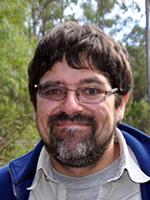Understanding the Minerals

Leader: Prof Joël Brugger, Monash University
Studying the products of uranium decay at the molecular level will help give us a clearer picture of their location and movement within copper-uranium ores.Prof Joël Brugger
The need for research
Iron oxide copper gold uranium (IOCG-U) ores in Australia are some of the most complex mineral systems in the world. As a result, extracting the copper, uranium, gold, silver and other commercially valuable metals is a technological challenge. Increasing the value and marketability of the copper from these ores relies on extracting the target economic metals, and leaving the so-called ‘non-target metals’ behind. To understand how we can extract these metals cheaply and reliably, we must first understand the mineral systems themselves.
We know very little about the physical and chemical conditions that formed these ores and how non-target metals are distributed within them. Learning more about these processes is the goal of this research.
Non-target metals
One non-target metal in IOCG-U ore from the Olympic Domain (Olympic Dam, Carrapateena and the Wirrda Well deposit) is uranium-238 (U-238). U-238 decays naturally over time, but at an extraordinarily slow rate.
Hub scientists from Monash University (Prof Joel Brugger), the University of Adelaide (A/Prof Nigel Cook) and Flinders University (Prof Allan Pring) will investigate two products of U-238 decay – polonium-210 (Po-210) and lead-210 (Pb-210) – to see where they sit within IOCG-U ore and also where they end up when the ore is processed into copper concentrate. This research will involve looking at the rocks right down to the individual atomic level, approaching the boundaries of technological analysis.
Prof Joël Brugger will look at how Po-210 and Pb-210 move through mineral systems. His team will develop a model for this chemical process that will help explain why these non-target metals move the way they do.
Prof Allan Pring ’s work will focus on how the natural process of radioactive decay affects the physical state of these rocks. In particular, his team will focus on how this process affects a rock’s porosity (number of tiny holes). Prof Pring believes that the creation of porosity during decay may affect the movement of Po-210 and Pb-210 through the system during mineral processing.
Why understanding the minerals matters
To produce triple bottom line outcomes for the mining industry and the greater society, it is important to have a thorough understanding of the natural IOCG-U mineral system and how metals behave during the extraction process. This research along with analysis of solid and liquid ore phases will help us to develop processing techniques to separate non-target metals from copper and produce high quality copper concentrates.
Interested in partnering with the Hub? Contact Prof Joël Brugger to get involved or register your interest to receive Hub research updates.
Our partners









